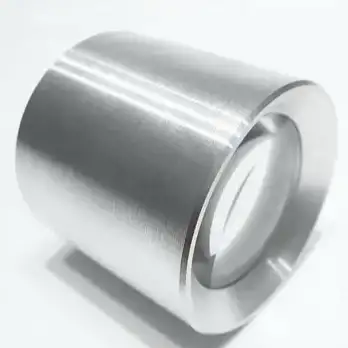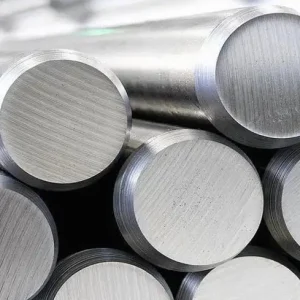Inconel Alloy 686 (UNS N06686 / W.Nr. 2.4606) is a single-phase, austenitic nickel-chromium-molybdenum-tungsten superalloy engineered for extreme resistance to mixed-acid and halide environments, excellent resistance to pitting/crevice corrosion and stress-corrosion cracking, and dependable mechanical stability over a broad temperature range. Where severe acid attack, seawater exposure or aggressive reducing/oxidizing mixtures are present, Alloy 686 is often the preferred choice over many stainless steels and several competing nickel alloys. For procurement, MWalloys manufactures and stocks Alloy 686 in multiple mill forms in China, offering 100% factory pricing and rapid stock delivery for standard sizes and common product forms (bar, plate, tube, wire).
What is Inconel Alloy 686?
Inconel Alloy 686 is a nickel-based superalloy formulated primarily for outstanding resistance to mixed-acid attack, localized corrosion (pitting and crevice), and stress-corrosion cracking in environments containing chlorides, sulfuric acid, hydrochloric acid and other aggressive media. Its chemistry — high nickel content coupled with elevated chromium, molybdenum and added tungsten — gives it superior performance where both oxidizing and reducing conditions occur together.
Specification
-
Trade name: INCONEL® alloy 686
-
UNS: N06686
-
Werkstoff / DIN: 2.4606 / NiCr21Mo16W
-
Common equivalents / synonyms: Alloy 686, NiCr21Mo16W, Hastelloy C-86 (similar family), ERNiCrMo-14 (welding filler designation).
Chemical composition
Below is a concise composition table suitable for engineering reference. Values are typical permissible ranges from datasheets and supplier specifications.
| Element | Typical range (wt%) |
|---|---|
| Nickel (Ni) | Balance (≈ 57–60 wt%) |
| Chromium (Cr) | 19.0 – 23.0 |
| Molybdenum (Mo) | 15.0 – 17.0 |
| Tungsten (W) | 3.0 – 4.4 |
| Iron (Fe) | ≤ 2.0 |
| C (Carbon) | ≤ 0.010 (low C to limit sensitization) |
| Si | ≤ 0.08 |
| Mn | ≤ 0.75 |
| Co | ≤ 1.0 |
| Ti, V, Al, P, S | Trace / per spec limits |
(Source: datasheet compilations and EN/UNS product tables.)
Material & mechanical properties
These are representative wrought-product values used for design and selection. Always confirm with mill certificates for critical components.
| Property | Typical metric | Typical imperial |
|---|---|---|
| Density | ~8.90 g/cm³ | ~0.321 lb/in³ |
| Tensile strength (room temp, annealed) | ~620–730 MPa (varies by product) | ~90–106 ksi |
| Yield strength (0.2% offset) | ~350–420 MPa | ~51–61 ksi |
| Elongation (in 50 mm) | 30–70% (form dependent) | 30–70% |
| Modulus of elasticity | ~200–210 GPa | ~29,000–30,000 ksi |
| Hardness (HRB) | ~75–95 (work/hardening dependent) | — |
(Representative values compiled from independent technical resources and manufacturer datasheets.)
Applicable standards & common mill forms
Common ASTM/ASME and EN standards used to specify forms of Alloy 686 include (but are not restricted to):
-
ASTM / ASME: ASTM B-574 / ASME SB-574 (bars), ASTM B-462 (plates), ASTM B-366 (wires for welding), ASTM B-575 / B-622 (tubes), ASTM B-564 (for forgings) — check the exact form and class.
Common product forms supplied from mills and warehouses:
-
Bars & rounds (solid shapes), rods, wire, sheets & plates, seamless/ERW tubing, pipe, forgings, weld filler wire and cladding electrodes.
Microstructure and why the alloy resists acids
Alloy 686 is intentionally engineered as a single-phase, solid-solution austenitic nickel alloy with very low carbon. The combination of:
-
High nickel — provides the matrix stability and general corrosion resistance.
-
High chromium — builds a passive oxide film for oxidizing conditions.
-
High molybdenum + tungsten — greatly improve resistance to localized corrosion (pitting, crevice) and performance in reducing acids.
-
Low carbon — minimizes grain boundary precipitation (carbides) and reduces susceptibility to intergranular corrosion after welding or high-temperature exposure.
Together, these features allow Alloy 686 to withstand mixed acid media that would rapidly attack many stainless steels or lower-alloy nickel grades. Lab comparisons show Alloy 686 frequently outperforms many Hastelloy and C-series grades in specific mixed-acid tests.
Alloy 686 vs Alloy 625 — principal differences
Both alloys share a nickel base, but their design priorities differ:
-
Alloy 625 (N06625) emphasizes excellent overall corrosion resistance plus high strength via niobium + molybdenum additions; it is broadly used for structural and high-temperature parts.
-
Alloy 686 (N06686) trades some general strength characteristics for a higher combined level of Mo + W + Cr, making it superior in pitting/crevice and mixed-acid environments; it is selected when localized acid attack is the main concern.
In practice, Alloy 625 is often chosen for structural, high-temperature or weldable applications with general corrosion exposure; Alloy 686 is chosen where aggressive acids or mixed oxidizing / reducing chemistries (for example, flue gas desulfurization, strong HCl/H2SO4 mixtures, or some pulp & paper process streams) require an alloy optimized for localized corrosion resistance. Comparative material databases quantify these differences in composition and many mechanical properties.
Typical industries & main uses
Alloy 686 is commonly specified where equipment must tolerate strong acids, chlorides, or mixed media. Examples:
-
Chemical processing: reactors, mixers, heat exchangers, piping handling sulfuric, hydrochloric and mixed acids.
-
Pollution control / FGD (flue gas desulfurization): ductwork, scrubber internals and piping exposed to acidic, chloride-containing condensates.
-
Pulp & paper and waste treatment: process vessels and piping in recovery liquor environments.
-
Marine & offshore: components subject to localized corrosion in seawater and chloride-bearing atmospheres.
-
Cladding & overlay applications: weld overlays or cladding on carbon steel to combine substrate strength with surface corrosion resistance (ERNiCrMo-14 filler recommendations often used).
Fabrication, welding and heat-treatment notes
-
Welding: Alloy 686 is readily welded with recommended filler metals (ERNiCrMo-14 family or alloy-specific filler such as Inco Weld 686CPT where available). Because of the low carbon content, susceptibility to sensitization is reduced, improving HAZ corrosion resistance when correct procedures are followed.
-
Forming & machining: Typical for nickel alloys — machinability is lower than austenitic stainless steels and requires sharp tooling, increased power and optimized feeds. Cold working improves strength but may affect local corrosion resistance; stress-relief procedures should follow mill recommendations.
-
Heat treatment: Solution annealing at specified temperatures followed by rapid quench is typical to restore ductility and corrosion resistance after fabrication; specific thermal cycles depend on product form and final properties required. Confirm against the mill’s heat-treatment recommendations.
Corrosion testing & performance summary
Independent test data across multiple laboratory media demonstrate Alloy 686’s strong standing on:
-
Pitting and crevice resistance in chloride-bearing acids and hot mixed acids.
-
Stress-corrosion cracking resistance in chloride environments compared to many stainless steels.
-
Mixed acid resistance (HCl + H₂SO₄ blends), outperforming many common Ni-Cr-Mo grades in aggressive “green death” style tests.
2025 global pricing practical ranges
Market prices for high-nickel superalloys fluctuate with raw material (nickel, molybdenum, tungsten) markets, processing form, minimum order quantity and certification level (commercial vs aerospace/AMS). Below are indicative ranges gathered from supplier listings and marketplace aggregators for 2025; use them for budgeting only — always request a firm quote for exact dimensions/quantity/certifications.
| Region / channel | Typical 2025 indicative price (USD / kg) | Notes / source |
|---|---|---|
| China (domestic suppliers, FOB) | USD 28 – 45 / kg | Manufacturer listings & marketplace ranges (MOQ impacts). |
| China (online B2B platforms / spot) | USD 20 – 40 /kg | Wholesale/lot pricing; small-lot sellers show wide variation. |
| Europe / distribution (mill + surcharge) | USD 35 – 60 /kg | Distributor + certification premia common; alloy surcharge data indicate higher alloy surcharge for 686 vs many other Inconel grades. |
| North America / special order | USD 40 – 70 /kg | Aerospace- or ASTM-certified material with traceability commands premium prices. |
Buyer tips: Prices step up significantly for full mill certification (MTR/EN 10204 3.1/3.2), small-quantity orders, and tight dimensional tolerances. For cladding wire, filler metals or specialist product forms (e.g., thin-gauge welded tubes), expect higher $/kg. Always request lead times and confirm alloy grade batch traceability.
FAQs
Q1. Is Alloy 686 suitable for seawater service?
Yes. Alloy 686 has strong local corrosion resistance in seawater and marine atmospheres; it resists pitting and crevice corrosion better than most stainless steels and many Ni-Cr grades, but selection depends on flow conditions, temperature and crevice geometry. Validate with application-specific tests.
Q2. Can Alloy 686 be welded to carbon steel?
Yes. via proper transition designs and use of appropriate filler metals (e.g., ERNiCrMo-14 family). Cladding or weld overlay is common to combine a corrosion-resistant surface with a lower-cost structural base. Follow preheat/interpass and post-weld practices recommended by suppliers.
Q3. How does Alloy 686 compare to Hastelloy C-276?
Alloy 686 performs competitively or better in many mixed-acid and localized corrosion tests. Exact ranking depends on specific media and temperature. Consult comparative test data for your exact service chemistry.
Q4. What product forms are commonly stocked?
Bars, plates, tubes, welded pipe, wire and filler rod. MWalloys stocks common sizes for fast shipment; custom dimensions require mill lead time.
Q5. Is Alloy 686 susceptible to sensitization after welding?
Low carbon content reduces carbide precipitation risk; however, correct welding practice and, if necessary, post-weld solution annealing help preserve corrosion resistance in HAZ.
Q6. What mechanical properties can I expect at elevated temperature?
Alloy 686 retains tensile strength and creep resistance at elevated temperatures typical for nickel superalloys, but design for creep needs alloy-specific curves; consult supplier fatigue/creep data for temperatures above ~400°C.
Q7. What certifications are typically available?
Mill Test Reports (MTRs) to EN 10204 3.1 / 3.2, ASTM/ASME product spec conformance (B574, B462, B622 etc.), and third-party inspection on request.
Q8. Can Alloy 686 be cold worked?
Yes; work hardening increases strength, but it can reduce local corrosion resistance in some conditions. Balance forming steps with solution anneal if corrosion resistance is critical.
Q9. Is Inconel® a trademark?
Yes — “INCONEL®” is a registered trade name historically owned by Special Metals/PCC. Many suppliers use the alloy designation (N06686) or equivalent trade names; ensure you specify UNS numbers and material documents when purchasing.
Q10. How to choose between 625 and 686?
If localized pitting/crevice resistance in aggressive mixed acids is the principal concern, prefer 686; if broad temperature strength and weldability for structural components is the priority, 625 may be preferable. Where in doubt, run a corrosion test under your exact process conditions or consult a corrosion engineer.
MWalloys supplier statement
MWalloys is a China-based mill and authorized distributor of nickel alloys. We stock Inconel Alloy 686 in bars, plates, tubes and wire for rapid dispatch. Our offer advantages:
-
Factory direct pricing (100% mill price) for standard dimensions.
-
Fast stock delivery for common sizes and certified mill lots.
-
Ability to provide MTRs and third-party inspection on request.
Contact MWalloys for formal quotation with required sizes, heat-treatment, and certification level; we will return a firm price and ETA.





